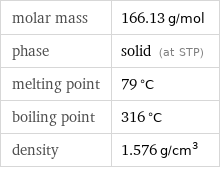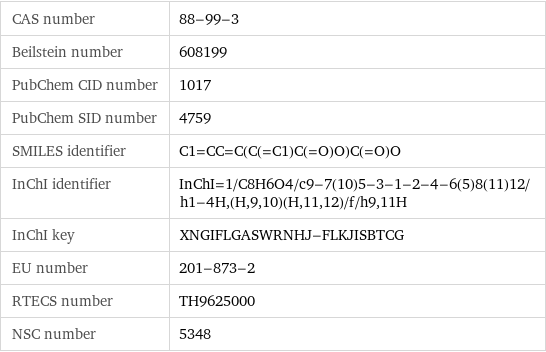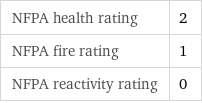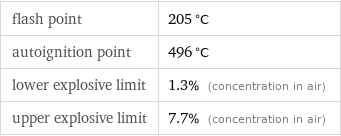Input interpretation

phthalic acid
Chemical names and formulas

formula | C_6H_4(COOH)_2 Hill formula | C_8H_6O_4 name | phthalic acid alternate names | 1, 2-benzenedicarboxylic acid | benzene-1, 2-dicarboxylic acid | o-benzenedicarboxylic acid | o-dicarboxybenzene | o-phthalic acid mass fractions | C (carbon) 57.8% | H (hydrogen) 3.64% | O (oxygen) 38.5%
Lewis structure

Draw the Lewis structure of phthalic acid. Start by drawing the overall structure of the molecule, ignoring potential double and triple bonds: Count the total valence electrons of the carbon (n_C, val = 4), hydrogen (n_H, val = 1), and oxygen (n_O, val = 6) atoms: 8 n_C, val + 6 n_H, val + 4 n_O, val = 62 Calculate the number of electrons needed to completely fill the valence shells for carbon (n_C, full = 8), hydrogen (n_H, full = 2), and oxygen (n_O, full = 8): 8 n_C, full + 6 n_H, full + 4 n_O, full = 108 Subtracting these two numbers shows that 108 - 62 = 46 bonding electrons are needed. Each bond has two electrons, so in addition to the 18 bonds already present in the diagram add 5 bonds. To minimize formal charge oxygen wants 2 bonds and carbon wants 4 bonds. Identify the atoms that want additional bonds and the number of electrons remaining on each atom: Fill in the 5 bonds by pairing electrons between adjacent highlighted atoms. Note that the six atom ring is aromatic, so that the single and double bonds may be rearranged: Answer: | |
3D structure

3D structure
Basic properties

molar mass | 166.13 g/mol phase | solid (at STP) melting point | 79 °C boiling point | 316 °C density | 1.576 g/cm^3
Units

Hydrophobicity and permeability properties

experimental LogP hydrophobicity | 0.73 predicted LogP hydrophobicity | 1.22 experimental LogS | -2.11 predicted LogS | -1.73
Basic drug properties

approval status | experimental | small molecule
Solid properties (at STP)

density | 1.576 g/cm^3 vapor pressure | 2×10^-6 mmHg (at 25 °C)
Units

Thermodynamic properties

molar heat of vaporization | 66.1 kJ/mol specific heat of vaporization | 0.398 kJ/g molar heat of combustion | 3224 kJ/mol specific heat of combustion | 19.41 kJ/g molar heat of fusion | 36.5 kJ/mol specific heat of fusion | 0.2197 kJ/g critical temperature | 800 K critical pressure | 3.95 MPa (at STP)
Chemical identifiers

CAS number | 88-99-3 Beilstein number | 608199 PubChem CID number | 1017 PubChem SID number | 4759 SMILES identifier | C1=CC=C(C(=C1)C(=O)O)C(=O)O InChI identifier | InChI=1/C8H6O4/c9-7(10)5-3-1-2-4-6(5)8(11)12/h1-4H, (H, 9, 10)(H, 11, 12)/f/h9, 11H InChI key | XNGIFLGASWRNHJ-FLKJISBTCG EU number | 201-873-2 RTECS number | TH9625000 NSC number | 5348
NFPA label

NFPA label

NFPA health rating | 2 NFPA fire rating | 1 NFPA reactivity rating | 0
Safety properties

flash point | 205 °C autoignition point | 496 °C lower explosive limit | 1.3% (concentration in air) upper explosive limit | 7.7% (concentration in air)
Toxicity properties

RTECS classes | mutagen | reproductive effector